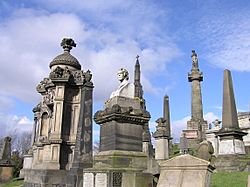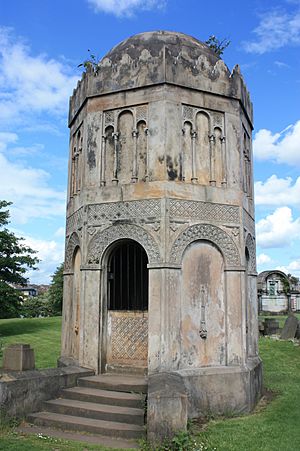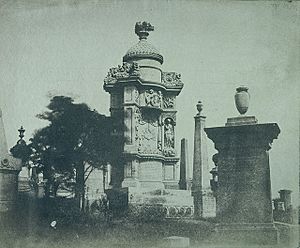Glasgow Necropolis facts for kids

Monuments on the summit of the Glasgow Necropolis hill
|
|
| Details | |
|---|---|
| Established | 1832 |
| Location | |
| Country | Scotland |
| Type | Public |
| Size | 37 acres (15 ha) |
| No. of interments | 50,000 |
The Glasgow Necropolis is a famous old cemetery in Glasgow, Scotland. It was built during the Victorian era, which was a time when Queen Victoria ruled Britain (from 1837 to 1901). This cemetery sits on a small but noticeable hill just east of Glasgow Cathedral. Over 50,000 people have been buried here.
Like many cemeteries from that time, not every grave has a stone. Also, only a small number of the buried people have their names on monuments. There are about 3,500 monuments in total.
Contents
Why the Necropolis Was Built
Before the 1800s, most people were buried in churchyards. But as cities like Glasgow grew, these churchyards became too full. People started wanting new, larger cemeteries. This idea became popular after the Père Lachaise Cemetery was created in Paris.
To build these new cemeteries, the law needed to change. This would allow companies to create cemeteries and charge for burials. Glasgow was one of the first cities to push for this change. The city's population was growing fast, and fewer people were attending church regularly.
The Merchants' House of Glasgow, a group of important business people, started planning the cemetery in 1831. They expected the law to change soon. The Cemeteries Act was passed in 1832, and the Glasgow Necropolis officially opened in April 1833. A small area for Jewish burials was set up in September 1832, just before the main cemetery opened.
History of the Necropolis
The tall column with a statue of John Knox at the top of the hill was built in 1825. This was even before the cemetery officially opened.
The first burials happened in 1832. These were in the lowest part of the cemetery and were only for Jewish people.
Many famous architects helped design the Necropolis. Alexander Thomson designed several tombs. David Hamilton and John Bryce also created other buildings and structures in the cemetery.
The main entrance to the Necropolis is reached by a bridge. This bridge crosses what was once a small stream called the Molendinar Burn. David Hamilton designed the bridge, which was finished in 1836. It became known as the "Bridge of Sighs." This name came from a famous bridge in Venice. It was called this because funeral processions, which are parades for the dead, would cross it. The fancy gates at the entrance were put up in 1838.
Near the gates and the bridge, there are three newer memorials:
- A memorial for still-born children.
- A memorial for the Korean War.
- A memorial for people from Glasgow who received the Victoria Cross, a very brave award.
When you cross the bridge, the original plan was to enter through a tunnel. But this idea didn't work out. The beautiful entrance from 1836 is still there today.
The Glasgow Necropolis was designed like a park, not a strict grid. This was common for early Victorian cemeteries. Its paths wind their way up the hill. Many of the biggest monuments are found at the top, close to the John Knox Monument.
The Necropolis has been called "literally a city of the dead." The famous comedian Billy Connolly, who is from Glasgow, once joked: "Glasgow's a bit like Nashville, Tennessee: it doesn't care much for the living, but it really looks after the dead."
Interesting Statues and Sculptures
The Necropolis is home to many amazing statues and sculptures. Here are a few examples:
- The tall monument to John Knox at the top of the hill has a 12-foot statue carved by Robert Forrest.
- The tomb of John Henry Alexander, a theatre manager, has a scene showing a stage. It used to have figures of "Tragedy" and "Comedy" on the sides. Sadly, one figure is now missing, and the other has no head.
- The tomb of Charles Tennant features a marble statue of him sitting down. Charles Tennant was a famous industrialist.
- The tomb of Walter Macfarlane, who owned the Saracen Foundry, has a special art-nouveau portrait panel.
- The Blackie publishing family tomb has a unique tomb slab designed by Talwin Morris.
- The monument to William McGavin has a statue created by Robert Forrest.
- There is a Celtic cross for Andrew McCall, designed by the famous architect Charles Rennie Mackintosh.
- The monument to Peter Lawrence has a statue called "Life" holding a torch that looks like it's going out.
- The tomb of Mrs Margaret Montgomerie features statues representing "Hope" and "Resignation."
War Graves
The Glasgow Necropolis also has graves for 19 soldiers from the Commonwealth. Fifteen of these soldiers died in World War I, and four died in World War II. Their graves are looked after by the Commonwealth War Graves Commission. One of the highest-ranking soldiers buried here is Lieutenant-General Sir James Moncrieff Grierson. He died in France in August 1914, and his body was brought back to Scotland.
The Jewish Section
A small area of land was set aside for Jewish burials. This was outside the main churchyard because Jewish people were not allowed to be buried in Christian burial grounds. This section has 57 burials.
Burials started here in 1832. This Jewish cemetery was used until 1855, when Jewish burials moved to another cemetery called the Eastern Necropolis.
Today, this small Jewish section is part of the larger Necropolis. It's in a lower area and sometimes its importance isn't fully recognized. This section was cleaned up and restored in 2015.
Other Memorials
- A memorial for the Cheapside Street whisky bond fire, a big fire that happened in Glasgow.
- A memorial for William Wallace, a Scottish hero.
Images for kids
See also
 In Spanish: Necrópolis de Glasgow para niños
In Spanish: Necrópolis de Glasgow para niños






